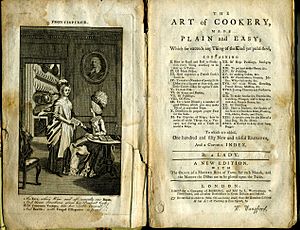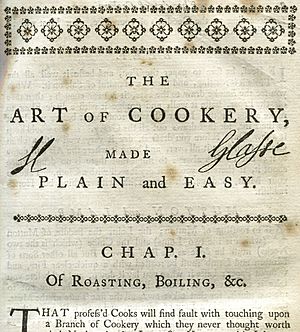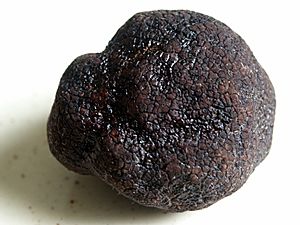The Art of Cookery Made Plain and Easy facts for kids

Frontispiece and title page in an early posthumous edition, published by L. Wangford, c. 1777
|
|
| Author | "By a LADY" (Hannah Glasse) |
|---|---|
| Country | England |
| Language | English |
| Subject | English cooking |
| Genre | Cookbook |
| Publisher | Hannah Glasse |
|
Publication date
|
1747 |
| Pages | 384 |
The Art of Cookery Made Plain and Easy is a famous cookbook written by Hannah Glasse (1708–1770). It was first published in 1747. This book became a huge bestseller and stayed popular for about 100 years. It was the most important cookbook in English-speaking countries for a long time. This made Hannah Glasse one of the most well-known cookbook writers of her era.
The book had at least 40 different versions published. Many of these were copied by others without Hannah Glasse's permission. It was also printed in Dublin starting in 1748 and in America from 1805. Hannah Glasse wrote in her introduction that she used simple words. She wanted servants to easily understand her recipes.
Later versions of the book added new and exciting recipes. The 1751 edition was the first to mention trifle with jelly. The 1758 edition was the first to talk about "Hamburgh sausages" and piccalilli. In 1774, the book included one of the first English recipes for an Indian-style curry. Glasse did not like too much French influence in British cooking. However, her book still had dishes with French names and French cooking ideas. She also used ingredients from other countries. These included cocoa, cinnamon, nutmeg, pistachios, and musk.
The book was very popular in the Thirteen Colonies of America. People kept using it even after the American Revolutionary War. Famous Americans like Benjamin Franklin, Thomas Jefferson, and George Washington owned copies of this cookbook.
Contents
About the Cookbook
The Art of Cookery was the main guide for home cooks in English-speaking countries. This was true during the late 1700s and early 1800s. Today, people still use it to learn about old recipes and how food was made back then. The book was updated many times, both while Hannah Glasse was alive and after she passed away.

The very first versions of the book did not have pictures. Some later editions, published after Hannah Glasse died, had a fancy picture at the front. This picture had a poem that talked about wise women using the book. It said they could make delicious food and stay healthy.
Some of the recipes in the book were copied directly from older cookbooks. To try and stop this, later versions had a warning on the title page. For example, the 1758 edition said that anyone who copied the book would be taken to court. Also, Hannah Glasse signed the first page of the main text with her own ink.
Hannah Glasse herself published the first edition of the book. She got money from people who paid in advance (called subscriptions). People who didn't subscribe could buy it at Mrs. Ashburn's China Shop.
What's Inside the Book?
The book has many chapters, each about a different type of cooking or food. Here are some examples:
- Chapter 1: How to Roast and Boil Food.
- Chapter 2: About Dishes that are "Made" (meaning they have many ingredients).
- Chapter 3: This chapter shows how expensive French sauces can be.
- Chapter 5: How to Cook Fish.
- Chapter 6: About Soups and Broths.
- Chapter 7: How to Make Puddings.
- Chapter 8: How to Make Pies.
- Chapter 10: Special Directions for People who are Sick.
- Chapter 11: Tips for Captains of Ships.
- Chapter 14: How to Pickle Foods.
- Chapter 15: How to Make Cakes.
- Chapter 21: How to Shop for Food and What Foods are in Season.
Cooking Style and Tips
The book has a short table of contents at the beginning. Then there's a note "To the Reader," and a full list of all the recipes by chapter. At the very end, there's an alphabetical list of all recipes.
Hannah Glasse explained in her note that she wrote simply. She wanted to "instruct the lower Sort," meaning people like kitchen helpers. She gave an example: instead of saying "large Lardoons" (a fancy cooking term), she would say "little Pieces of Bacon." This way, everyone would understand. She thought that "great Cooks" used words that "poor Girls" (kitchen staff) couldn't understand.
Besides being simple, Glasse also wanted to help people save money. She said some fancy ingredients were "extravagant." She believed a dish could be just as good, or even better, without them.
Each chapter often starts with general advice on the topic. For example, a chapter on meat might give tips on cooking it. The rest of the chapter is filled with recipes. The recipes do not tell you how long to cook something or what oven temperature to use. They also don't have separate lists of ingredients. Instead, the recipe tells you what to do and what quantities to use as you go. Many recipes don't even say how much of an ingredient to use. They just tell you what to do, like this example for "Sauce for Larks":
Sauce for Larks.
LARKS, roast them, and for Sauce have Crumbs of Bread; done thus: Take a Sauce-pan or Stew-pan and some Butter; when melted, have a good Piece of Crumb of Bread, and rub it in a clean Cloth to Crumbs, then throw it into your Pan; keep stirring them about till they are Brown, then throw them into a Sieve to drain, and lay them round your Larks.
Recipes from Around the World

Hannah Glasse shared her thoughts on French cooking in the book's introduction. She said she gave some dishes French names because that's what they were known by. She believed it didn't matter if a dish had a French, Dutch, or English name, as long as it tasted good and wasn't too expensive to make. For example, her "To à la Daube Pigeons" recipe uses a French cooking style. A daube is a rich French meat stew. Her "A Goose à la Mode" is served with a sauce made with red wine, homemade "Catchup," and fancy ingredients like veal sweetbread, truffles, and morel mushrooms. She also used some French ingredients, like "right French Brandy" in her "To make a rich Cake" recipe.
Over time, newer versions of the book added more recipes from other countries. These included German, Dutch, Indian, Italian, West Indian, and American dishes. For example, the recipe for "Elder-Shoots, in Imitation of Bamboo" used a common English plant to copy a foreign ingredient. This recipe also called for many imported spices like white or red pepper, ginger, mace, and Jamaica pepper.
Lasting Impact
The saying "First catch your hare" is often thought to come from Hannah Glasse. However, her actual recipe says, "Take your Hare when it is cas'd, and make a pudding..." To "case" a hare means to remove its skin, not to catch it. This shows how her words have been remembered, even if they're sometimes misquoted.
Today, some restaurants still use Hannah Glasse's recipes. For example, as of 2015, Scott Herritt's "South End" restaurant in South Kensington, London, served some dishes from her book. Websites like "Nourished Kitchen" also talk about the challenge of turning her 18th-century recipes into modern cooking instructions.
Book Editions
The Art of Cookery was printed many, many times. Here are just a few examples of its different editions:
- First edition, London: Printed for the author, 1747.
- London: Printed for the author, 1748.
- Dublin: E. & J. Exshaw, 1748.
- Sixth edition, London: Printed for the author, sold by A. Millar, & T. Trye, 1758.
- London: W. Strahan and 30 others, 1770.
- Edinburgh: Alexander Donaldson, 1774.
- Alexandria, Virginia: Cottom and Stewart, 1805.
- London: Orlando Hodgson, 1836.
- Mineola, New York: Dover Publications, 2015.
See also
 In Spanish: Art of Cookery para niños
In Spanish: Art of Cookery para niños

